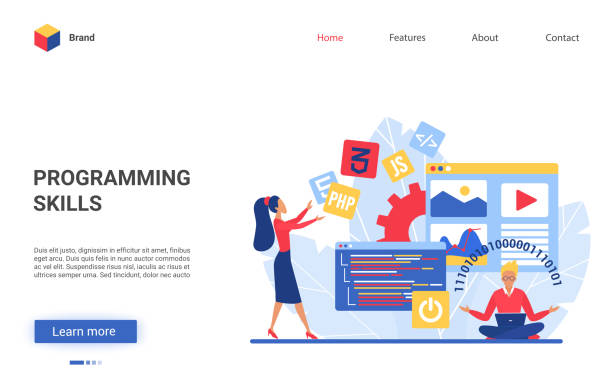Introduction to the Importance of E-commerce Website Design in the Digital Age
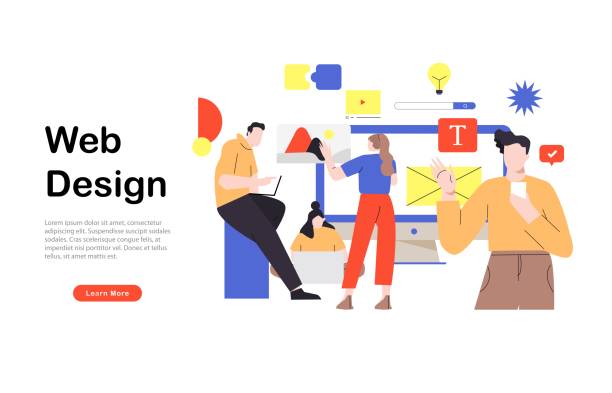
In today’s rapidly #digitalizing world, having a successful #online_business is no longer a luxury, but a vital necessity for survival and growth.
At the heart of this digital transformation, e-commerce website design plays a pivotal role.
This process not only allows you to offer your products or services to a wide range of customers worldwide, but also provides unparalleled opportunities for direct communication with your audience and precise analysis of their behavior.
With the increasing number of internet users and their inclination towards online shopping, investing in a professional online store can bring you a significant competitive advantage.
An e-commerce website is not merely a virtual storefront; it is a powerful marketing, sales, and customer service tool that, if properly designed and managed, can generate a sustainable revenue stream for your business.
This involves creating a secure, efficient, and attractive e-commerce platform that delivers a pleasant shopping experience for users and converts them into loyal customers.
In this era of #intense_competition, your website must not only be beautiful but also easy to use, fast, and reliable to meet the changing market needs and high customer expectations.
Did you know that 94% of a first impression of a company is related to its website design?
Rasaweb, by offering professional corporate website design services, helps you create the best first impression.
✅ Create a professional and trustworthy image for your brand
✅ Easier attraction of potential customers and improvement of online positioning
⚡ Get free corporate website design consultation
Basic Steps of E-commerce Website Design from Idea to Implementation
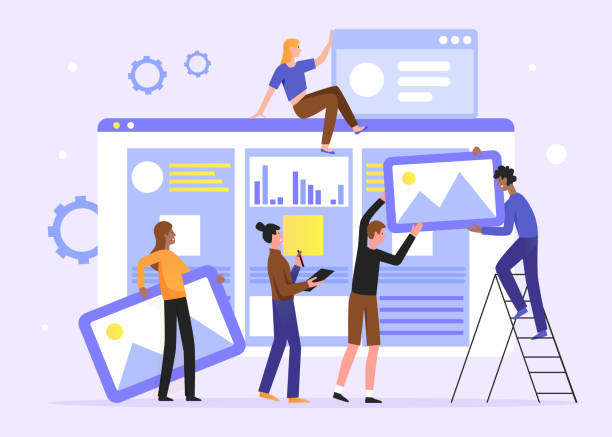
The process of e-commerce website design requires a structured approach and precise planning to ensure its success.
The first step is the planning phase, where business goals, target audience, product or service types, and budget are determined.
During this stage, competitor analysis and market research are also highly important to enable you to create differentiation.
After planning, it’s time to choose the right platform, which could be WooCommerce, Shopify, Magento, or a custom solution; this choice depends on your specific needs and expected scalability.
Then, the visual design and user interface (UI) and user experience (UX) phase begins.
In this section, the site’s look and feel, page layout, easy navigation, and visual appeal become important to ensure users have a pleasant shopping experience.
Following that, is the development and programming phase, which includes implementing features, #payment_gateway_integration, inventory management system, and other technical capabilities.
Comprehensive testing and evaluation of the website before launch is essential to identify and fix any bugs or technical flaws.
This includes performance testing, loading speed, compatibility with various browsers and devices, and security.
Finally, after ensuring all sections function correctly, the website is launched.
But the work doesn’t end there; after launch, continuous monitoring, content updates, and Search Engine Optimization (SEO) are vital for attracting traffic and increasing sales.
Each of these steps must be performed with precision and attention to detail to ensure the final result is an efficient and successful online store.
Choosing the Right Platform for Online Store Design and Comparing Them
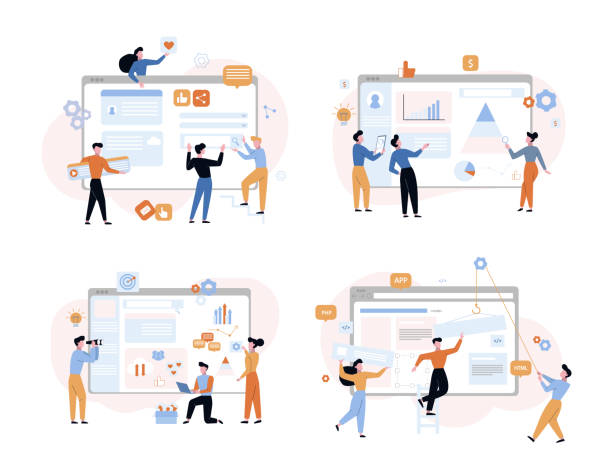
One of the most important decisions in online store design is choosing the right platform.
This choice not only affects the initial cost and development time but also impacts scalability, future capabilities, and ease of daily management.
Various platforms exist in the market, each with its own unique features and advantages.
For example, Shopify is a popular option for small and medium-sized businesses, known for its ease of use, strong support, and numerous ready-made templates.
However, it has monthly costs and limitations in full customization.
WooCommerce, a plugin for WordPress, offers very high flexibility and is ideal for businesses that want full control over their site.
However, its use requires more technical knowledge, and server and security management are the user’s responsibility.
Magento is also a powerful and scalable platform suitable for large companies and businesses with complex needs, but its development and maintenance complexity and cost are very high.
In addition to these, there are other open-source platforms like OpenCart and PrestaShop, each with its own advantages and disadvantages.
Platform selection should be based on current business needs, budget, team’s technical skills, and future growth and development plans.
In some specific cases, developing a custom platform can also be the best option, although it is usually more expensive and time-consuming.
To aid in better decision-making, the table below provides a brief comparison between some of the most popular e-commerce platforms:
| Feature | WooCommerce | Shopify | Magento |
|---|---|---|---|
| Ease of Use | Medium to High (requires familiarity with WordPress) | Very High | Medium to Low (requires expertise) |
| Cost | Medium (requires hosting and plugins) | Monthly (based on plan) | High (requires specialized development) |
| Scalability | High (with suitable hosting) | High | Very High |
| Flexibility and Customization | Very High | Medium (limited to themes and apps) | Very High |
| Support | Relies on community and developers | Shopify 24/7 support | Relies on specialized developers |
| Security | User’s responsibility (requires settings and plugins) | Managed by Shopify | User’s responsibility (requires expertise) |
The Importance of User Interface (UI) and User Experience (UX) in Successful E-commerce Website Design
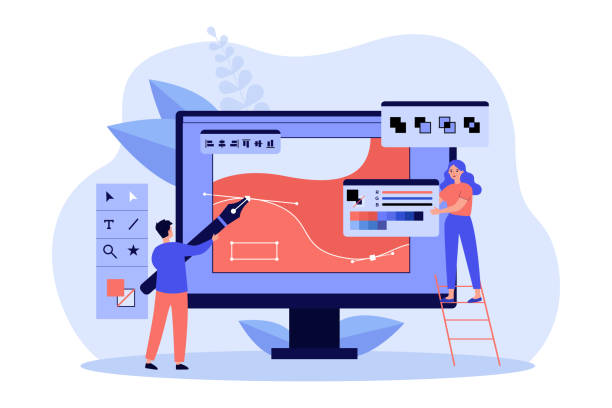
In the dynamic world of e-commerce, merely having a website is not enough; the website must be designed to attract users, guide them through the purchasing process, and provide them with a pleasant and hassle-free experience.
This is where the importance of User Interface (UI) and User Experience (UX) in e-commerce website design becomes prominent.
UI refers to the visual and interactive appearance of a website; meaning the buttons, colors, fonts, images, and overall layout that the user interacts with.
A beautiful and harmonious UI can convey a sense of trust and professionalism.
But UX goes beyond aesthetics; this concept refers to the user’s overall feeling when using the website.
Is navigation easy? Is finding desired products not challenging? Is the payment process smooth and without complications? Good UX means the user can easily and without confusion achieve their goal.
Strong UX design reduces bounce rates, increases time spent on the site, and ultimately boosts conversion rates.
For example, a product page that provides complete information and high-quality images of the product, allows one-click addition to the cart, and displays customer reviews, has good UX.
The payment process should also be as simple and fast as possible, with minimal steps and diverse payment options.
Investing in excellent UI/UX for an e-commerce website means investing in customer loyalty and long-term sales growth, as a great user experience makes customers return to your site and make purchases again.
Does your company’s website perform as it deserves for your brand? In today’s competitive world, your website is your most important online tool. Rasaweb, a specialist in professional corporate website design, helps you to:
✅ Build customer credibility and trust
✅ Convert website visitors into customers
⚡ Get a free consultation!
Introducing Key Features of an Efficient E-commerce Website

For an e-commerce website to become a powerful revenue-generating tool, it must incorporate a set of key features that optimize the shopping experience for customers and streamline management processes for the business owner.
One of the most fundamental features is secure and diverse payment gateways.
Customers expect to be able to finalize their purchases using various bank cards, e-wallets, or even cash-on-delivery methods.
SSL certificate is essential for encrypting data and creating a secure environment for transactions.
Furthermore, an efficient Inventory Management system that automatically updates product stock and prevents out-of-stock sales is of paramount importance.
Responsive Design, meaning the site is displayed correctly on all devices including mobile and tablet, is an undeniable necessity today, as a significant portion of purchases are made via mobile devices.
Advanced search and product filtering capabilities help users quickly find their desired products.
The ability for customers to add reviews and ratings not only helps other shoppers in decision-making but also increases Social Proof.
Strong customer support, through online chat, phone, or email, and clear display of contact information, reassures users.
Finally, an Order Management system that allows for tracking orders and managing returns is essential for an efficient online store.
Search Engine Optimization (SEO) in E-commerce Website Design

Having a beautiful and efficient e-commerce website is only half the battle.
For potential customers to find your site, Search Engine Optimization (SEO) is crucial.
SEO is a set of techniques that improves your website’s ranking in Google and other search engine results, thereby driving more organic (free) traffic to your site.
In e-commerce website design, SEO should be considered from the very initial stages.
This includes selecting appropriate keywords for products and categories, optimizing page titles (Title Tags) and meta descriptions for each product, and using SEO-friendly URLs.
Also, image optimization (compression and use of Alt Text) is important for loading speed and discoverability by search engines.
High-quality and unique content for product descriptions, blog articles related to your industry, and buying guides can help attract traffic and improve rankings.
Creating a strong internal linking structure that connects different pages of the site and ensuring the presence of a Sitemap, which helps search engines crawl the site better, are other important points.
Site loading speed, mobile compatibility, and site security (using HTTPS) are also crucial factors for SEO.
By focusing on these SEO principles, you can ensure that your online store is optimized not only for customers but also for search engines, which will lead to greater visibility and increased sales.
E-commerce Website Security and User Privacy Protection
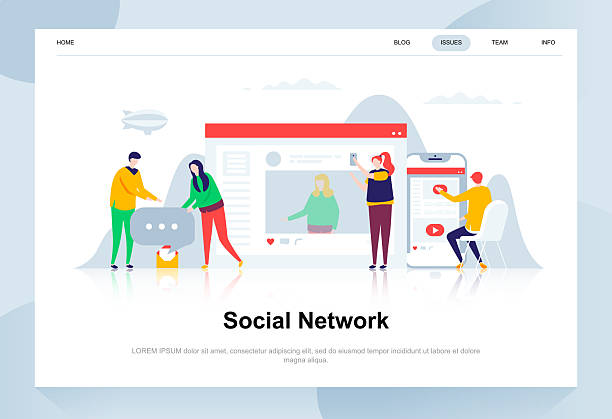
Security in e-commerce website design is not just a feature, but a fundamental and indispensable necessity.
Given the high volume of sensitive customer information exchanged on an e-commerce website, including personal details, addresses, and banking information, protecting their security and privacy is of particular importance.
The first and most important step is to use an SSL (Secure Sockets Layer) certificate.
This certificate encrypts the information exchanged between the user and the server and prevents unauthorized access to it.
Websites with SSL are identified by ‘https://’ in the browser address and display a green padlock icon, which reassures users.
In addition to SSL, implementing strong security protocols for online payments (PCI DSS Compliance) is mandatory for any online store that processes credit card information.
These standards set strict requirements for protecting payment data.
Also, protection against common cyber-attacks such as XSS (Cross-Site Scripting), SQL Injection, and DDoS attacks is essential.
Using powerful firewalls, intrusion detection systems, and regular updates of platform software and plugins can help increase security.
Protecting user privacy also involves transparency about how their information is collected, used, and stored, which should be explained through clear and accessible Privacy Policies.
These measures not only protect your business from financial and reputational damage but also build customer trust and increase their loyalty.
For better understanding, the table below lists some of the most common security measures for e-commerce websites:
| Security Measure | Description | Importance |
|---|---|---|
| SSL/TLS Certificate | Encrypts data between user and server | Essential for transaction security and user trust |
| PCI DSS Compliance | Data security standards for processing payment cards | Mandatory for any card-processing business |
| Firewall (WAF) | Protection against web-based attacks | Prevents common attacks like SQL Injection and XSS |
| Regular Backups | Creates backup copies of the entire site and database | Rapid recovery in case of issues or attacks |
| Software Updates | Regular installation of platform, plugin, and theme updates | Fixes known security vulnerabilities |
| Strong Passwords | Requires users and administrators to use complex passwords | Reduces the risk of unauthorized access |
Marketing and Advertising After Creating an Online Store
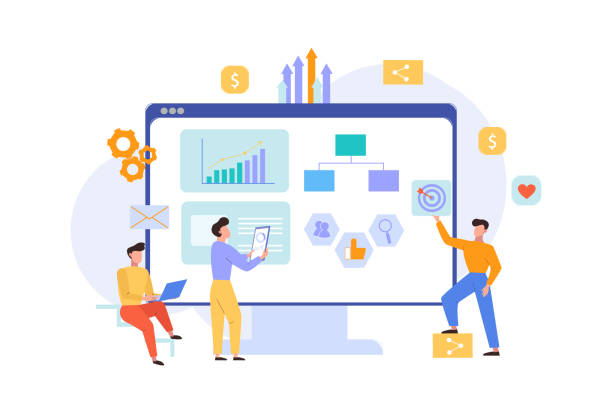
After successfully creating an online store, the next and very important step is marketing and advertising to attract customers and increase sales.
Without an effective marketing strategy, even the best website will go unnoticed.
#Digital_marketing encompasses a set of tactics that help you reach your target audience and convert them into customers.
One of the most powerful tools is Content Marketing.
Creating valuable and relevant content related to your products, such as blog articles, buying guides, videos, and infographics, not only helps SEO but also builds user trust and establishes you as a credible source in your industry.
Social media marketing is also very effective for increasing brand awareness and customer engagement.
Paid advertising like Google Ads (PPC) and social media ads (such as Facebook Ads) can drive targeted and fast traffic to your site.
Email marketing is also an excellent tool for maintaining communication with existing customers and encouraging repeat purchases.
Offering discount codes, announcing new products, and engaging newsletters can increase customer retention rates.
Collaborating with influencers, launching creative advertising campaigns, and participating in online events related to your field can also help expand your visibility.
Analyzing data and the performance of marketing campaigns to identify strengths and weaknesses and continuously optimize strategies is crucial.
This multifaceted approach to marketing ensures that your e-commerce website not only attracts customers but also converts them into loyal buyers.
Did you know that your company’s website is the first point of contact for 75% of potential customers?
Your website is the face of your brand. With **Rasaweb**’s corporate website design services, build an online presence that earns customer trust.
✅ Create a professional and lasting image for your brand
✅ Attract target customers and increase online credibility
⚡ Get a free consultation from **Rasaweb** experts!
Continuous Support and Development of E-commerce Website
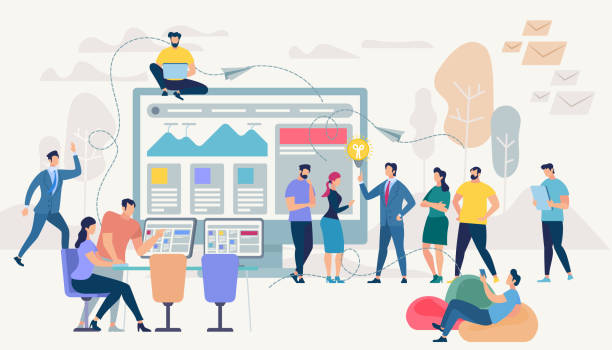
After initial launch and marketing, continuous maintenance and development of the e-commerce website are equally vital.
A dynamic and successful online store is never left to its own devices.
#Regular_technical_support includes software updates, bug fixes, and website performance monitoring to ensure its speed and availability.
Ignoring updates can make your site vulnerable to security threats and degrade its performance.
#Continuous_improvement involves analyzing user behavior, gathering their feedback, and implementing new features to enhance the user experience.
This can include improving the payment process, adding new options for product filtering, or upgrading the search system.
Data analysis through tools like Google Analytics provides valuable insights into how users interact with your site, helping you make data-driven decisions for future developments.
Also, A/B testing for comparing different versions of pages and site elements to determine the best performance is a powerful tool.
As the business grows, the need for scalability of the site’s infrastructure also increases; this can include upgrading hosting, using a CDN (Content Delivery Network) to speed up image and video loading, and database optimization.
Providing excellent customer support is also part of continuous development; responding quickly to questions and resolving customer issues not only helps retain them but can also lead to increased sales through word-of-mouth.
This commitment to maintenance and development ensures that your e-commerce website always remains at its peak performance and responds to the changing needs of the market and customers.
Challenges and Opportunities in Online Store Design and the Future of E-commerce

The path of online store design and its management is not without challenges.
#Intense_competition, continuous changes in search engine algorithms, #increasing_marketing_costs, and rising customer expectations are just some of the obstacles businesses face.
Also, maintaining cybersecurity against more sophisticated attacks and efficient inventory and logistics management can be very challenging.
However, alongside these challenges, unique opportunities also await those who are ready to leverage new technologies and adopt creative approaches.
The future of e-commerce is full of innovations.
#Artificial_Intelligence (AI) and Machine Learning are transforming how customers interact with online stores; from personalized product recommendations to advanced chatbots for customer support.
Augmented Reality (AR) and Virtual Reality (VR) have the potential to create immersive and realistic shopping experiences, allowing customers to virtually try products before purchasing.
Voice Commerce, through voice assistants like Alexa and Google Assistant, offers a new way to shop.
New business models such as Subscription Boxes and Dropshipping are also growing.
To succeed in this evolving landscape, online stores must be flexible, adapt quickly to changes, and constantly focus on improving customer experience and innovation.
Understanding these challenges and opportunities is key to strategic planning for online store design and ensuring sustainable growth in the future of e-commerce.
Frequently Asked Questions
| Question | Answer |
|---|---|
| What is e-commerce website design? | The process of creating an online platform for displaying, selling, and managing products or services to customers on the internet. |
| Why is User Interface (UI) and User Experience (UX) design important for an e-commerce website? | Good UI/UX design allows users to easily navigate the site, find their desired product, and complete the purchasing process without issues, which leads to increased sales and customer satisfaction. |
| What features should be included in a professional e-commerce website? | Comprehensive product catalog, user-friendly shopping cart, product comparison feature, strong filtering and search system, secure payment gateway, user panel, customer review section, and mobile optimization. |
| Which platforms are commonly used for e-commerce website design? | Ready-made platforms like WooCommerce (on WordPress), Shopify, Magento, as well as custom development depending on project needs and budget. |
| What are the most important security considerations in e-commerce website design? | Using HTTPS (SSL) protocol, payment gateway security, protection against common attacks (such as SQL Injection, XSS), and regular updates of the platform and plugins. |
And other services of Rasa Web Advertising Agency in the field of advertising
Smart Content Strategy: Designed for businesses looking to manage campaigns through attractive UI design.
Smart Social Media: A creative platform for improving customer acquisition with marketing automation.
Smart Digital Advertising: Designed for businesses seeking online growth through attractive UI design.
Smart Marketplace: An effective tool for customer acquisition with the help of marketing automation.
Smart Brand Identity: Designed for businesses looking to increase website visits through key page optimization.
And over hundreds of other services in internet advertising, advertising consultation, and organizational solutions
Internet Advertising | Advertising Strategy | Advertorial
Resources
Comprehensive Guide to E-commerce Website DesignStrategies for Successful Online Store DesignOnline Store Marketing StrategiesE-commerce Website SEO Guide
? To reach the pinnacles of success in the digital world, Rasaweb Afarin Digital Marketing Agency, specializing in user-friendly website design and comprehensive online marketing strategies, is your reliable partner.
📍 Tehran, Mirdamad Street, next to Bank Markazi, Southern Kazeroun Alley, Ramin Alley, No. 6


